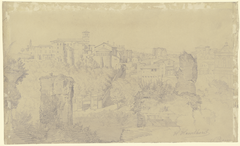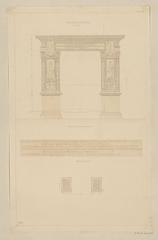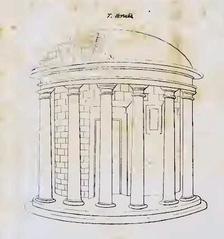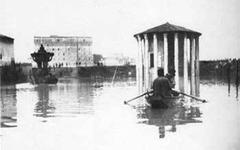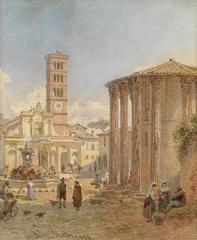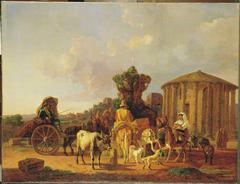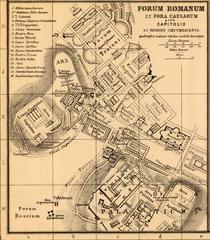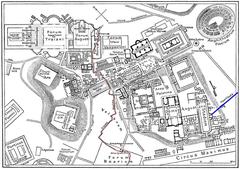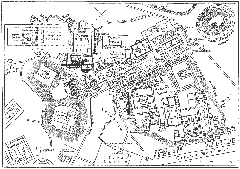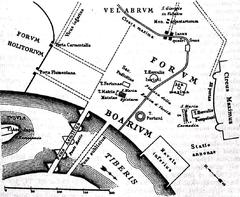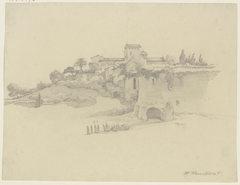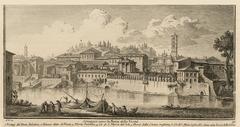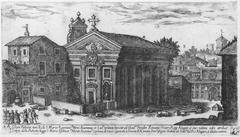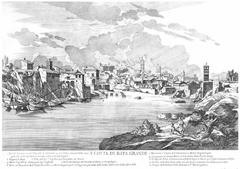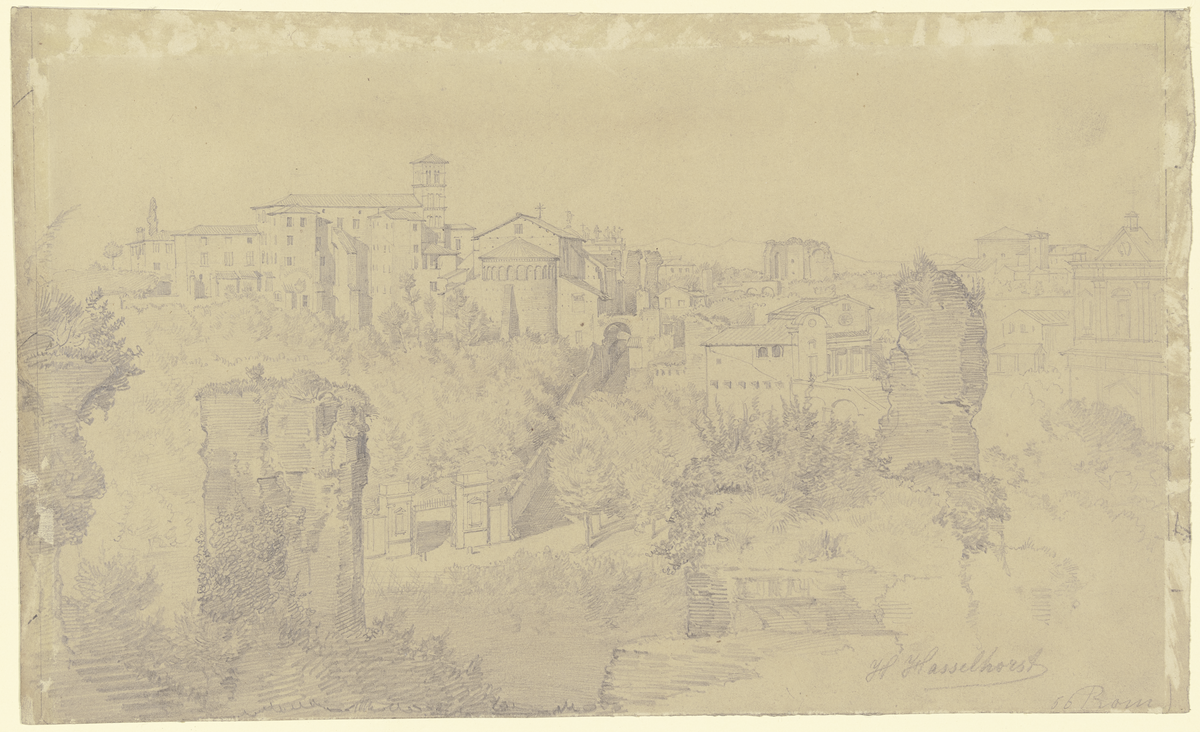
Forum Boarium Visiting Hours, Tickets, and Historical Significance Guide – Rome, Italy
Date: 14/06/2025
Introduction
Nestled along the Tiber River and framed by the Capitoline, Palatine, and Aventine hills, the Forum Boarium is among Rome’s most ancient and evocative sites. Once a bustling cattle market—its name derived from the Latin “boarium,” meaning “of cattle”—the Forum predates the celebrated Roman Forum and encapsulates centuries of commerce, religion, and civic life. Its transformation from a marshy riverside into a commercial hub was driven by the Etruscan kings in the 6th century BCE, notably Servius Tullius, who founded Rome’s earliest river port, the Portus Tiberinus (A View on Cities; Imperium Romanum).
Today, the Forum Boarium is home to remarkably preserved monuments like the Temple of Hercules Victor and the Temple of Portunus, both testaments to the area’s architectural and religious significance. As an open-air archaeological zone, the Forum is freely accessible year-round, offering an immersive and budget-friendly experience for travelers. Its central location, near sites like the Bocca della Verità and Circus Maximus, makes it a perfect gateway to Rome’s layered history (Italia.it; Rome.net).
This comprehensive guide will provide an in-depth overview of the Forum Boarium: its origins, cultural and religious importance, architectural highlights, practical visitor information, and tips for making the most of your visit.
Table of Contents
- Origins and Early Development
- Religious and Social Significance
- Architectural Highlights
- Historical Events and Transformations
- Visiting the Forum Boarium: Practical Information
- Frequently Asked Questions (FAQ)
- Visuals and Interactive Elements
- The Forum Boarium in Broader Roman History
- Plan Your Visit
- Summary and Final Visitor Tips
- References
Origins and Early Development
The Forum Boarium is Rome’s oldest forum, its name reflecting its original purpose as the city’s main cattle market. Strategically located by the Tiber River, the site quickly became a commercial center for goods ranging from livestock to grain and oil (A View on Cities; Imperium Romanum). Originally a swamp, the area was drained in the 6th century BCE by the Cloaca Maxima, one of the world’s earliest sewage systems, facilitating the construction of markets and temples (aroundrome.it).
The Etruscan kings, especially Servius Tullius, oversaw the transformation of this area. The establishment of the Portus Tiberinus enabled river-based trade, further cementing the forum’s economic significance (Visit Colosseum Rome).
Religious and Social Significance
Far more than a marketplace, the Forum Boarium served as a sacred and civic heart of early Rome. The presence of temples—including the Temple of Hercules Victor and the Temple of Portunus—reflects its religious importance. The Great Altar of Hercules (Ara Maxima Herculi), among Rome’s oldest cult sites, was central to rituals and sacrifices, symbolizing the fusion of commerce and divinity in Roman life (Imperium Romanum; History Tools).
The forum’s architecture, particularly the Greek-inspired Temple of Portunus, highlights cultural interplay. Socially, the area was frequented by merchants, traders, and the city’s equestrian class, underlining its role as a crossroads of economic and social exchange.
Architectural Highlights
Temple of Hercules Victor
The oldest surviving marble building in Rome, the Temple of Hercules Victor, dates to the late 2nd century BCE. Its distinctive circular plan and twenty Corinthian columns are modeled after Greek tholoi, emphasizing the Hellenistic influence on Roman architecture (History Tools; colosseumrometickets.com). Its preservation is owed to its medieval conversion into a Christian church (aroundrome.it).
Temple of Portunus
Close by, the Temple of Portunus (late 2nd or early 1st century BCE) is a rectangular Ionic temple dedicated to the god of ports and keys. Its survival is largely due to its adaptation as a church, Santa Maria Egiziaca, from the 9th century (colosseumrometickets.com).
Cloaca Maxima
Remnants of the Cloaca Maxima, a monumental sewer built in the 6th century BCE, are still visible. This engineering marvel drained the swamp, enabling the area’s urban development (aroundrome.it).
Arch of Janus and Arco degli Argentari
The Arch of Janus, a rare quadrifrons arch from the 4th century CE, marks the forum’s importance as a crossroads. Nearby, the Arco degli Argentari, erected in 204 CE by money changers, reflects the forum’s commercial legacy (aroundrome.it).
Bocca della Verità
Housed in the portico of Santa Maria in Cosmedin, the Bocca della Verità (“Mouth of Truth”) is a legendary marble mask, said to bite the hand of liars, and a popular visitor attraction (aroundrome.it).
Fontana dei Tritoni
This Baroque fountain, built in the 17th century, adds visual charm and is a favorite spot for photos (audiala.com).
Historical Events and Transformations
The Forum Boarium was the site of Rome’s first recorded gladiatorial games in 264 BCE (Imperium Romanum). Despite floods and fires, many ancient structures survived. In the medieval era, several temples were converted into churches, ensuring their preservation. Extensive restoration, particularly since the 1990s, has further stabilized and showcased the monuments (audiala.com).
Visiting the Forum Boarium: Practical Information
Visiting Hours and Tickets
- Open Area: The Forum Boarium is an open public space, accessible 24/7. There are no gates or admission fees to enter the piazza or view the exterior of the temples (Rome.net; Lions in the Piazza).
- Temple Interiors: Interior access is typically restricted, except during occasional guided tours or special events (Rome.net).
- Churches: Nearby churches like Santa Maria in Cosmedin (typically open 9:30–17:50) are free to enter, with donations welcome.
Accessibility and Transport
- Address: Piazza Bocca della Verità, 00186 Roma RM, Italy (Italia.it)
- By Bus: Routes 44, 81, 95, 160, 170, and 628 stop at Piazza Bocca della Verità.
- By Metro: Circo Massimo (Line B) is a 10–15 minute walk.
- On Foot: Easily reached from Circus Maximus, Trastevere, or the Capitoline Hill.
- Mobility: The area is mostly flat and paved, suitable for wheelchairs and strollers, though some cobblestones and steps exist.
Nearby Attractions and Suggested Itineraries
- Santa Maria in Cosmedin: Home to the Bocca della Verità and the ancient Ara Maxima Herculis.
- Circus Maximus: Ancient chariot racing stadium, a short walk away.
- Capitoline Museums: World-class art and Roman artifacts.
- Aventine Hill: The Orange Garden (Giardino degli Aranci) offers panoramic city views.
- Trastevere: Cross the river for vibrant streets and restaurants (Italia.it).
Best Times to Visit and Travel Tips
- Best Lighting: Early morning and late afternoon for photography.
- Crowds: The forum is rarely crowded, making it ideal for peaceful exploration (Lions in the Piazza).
- Weather: Spring and early summer are pleasant. Bring sun protection in hot months.
- Amenities: Benches and some shade are available in the piazza; public restrooms nearby at Santa Maria in Cosmedin.
- Safety: The area is generally safe, but be mindful of pickpockets in busier spots.
Frequently Asked Questions (FAQ)
Q: What are the Forum Boarium visiting hours?
A: The site is open 24/7. Temple interiors are accessible only during special events or tours.
Q: Is there an admission fee?
A: No, visiting the forum and viewing the temples from outside is free.
Q: How do I get there?
A: By bus (routes above), metro (Circo Massimo), or on foot from nearby landmarks.
Q: Are the temples open to the public?
A: Exteriors are always accessible. Interiors open occasionally for guided tours.
Q: Is the area accessible for people with disabilities?
A: The piazza is mostly flat and accessible, though some uneven surfaces exist.
Q: Are guided tours available?
A: Yes, several operators offer walking tours that include the Forum Boarium and surrounding sites.
Visuals and Interactive Elements
Enhance your visit by consulting interactive maps and high-quality images via the Audiala app or official websites. Use SEO-optimized alt text like “Temple of Hercules Victor at Forum Boarium Rome” for photos. Virtual tours and audio guides are available for remote exploration.
The Forum Boarium in Broader Roman History
The Forum Boarium illustrates Rome’s evolution from a riverside village to a cosmopolitan capital. Its architecture reflects both Greek and Roman influences, while its enduring cult sites and commercial roots reveal the interplay of economy, religion, and social hierarchy in Roman society (History Tools).
Plan Your Visit
- Combine your visit with nearby sites like the Circus Maximus, Capitoline Hill, and Trastevere for a full day of exploration.
- Download the Audiala app for audio guides, interactive maps, and up-to-date information.
- Check local event calendars for special openings, guided night tours, and cultural events, especially during major Roman holidays (romewise.com).
Summary and Final Visitor Tips
The Forum Boarium remains a testament to Rome’s blend of commerce, religion, and urban design. Its iconic temples, legendary arches, and surrounding churches offer a window into the city’s ancient spirit. With free year-round access, excellent public transport connections, and proximity to other major sites, it’s an essential—and peaceful—stop for any traveler.
For the best experience, visit in the early morning or late afternoon, respect the archaeological remains, and enjoy the site’s unique atmosphere where history unfolds at every turn.
References Including Official Sources and Related Articles
- A View on Cities – Forum Boarium Rome
- Imperium Romanum – Forum Boarium
- History Tools – Unveiling the Secrets of the Forum Boarium’s Temples
- Visit Colosseum Rome – Forum Boarium Tickets & Tips
- Italia.it – Forum Boarium
- Rome.net – Forum Boarium
- Audiala – Temple of Hercules Victor
- colosseumrometickets.com – Forum Boarium
- aroundrome.it – Foro Boario: The Beating Heart of Ancient Rome
- Lions in the Piazza – Forum Boarium
- The Geographical Cure – Forum Boarium in Rome
- Turismo Roma – Forum Boarium
- romewise.com – Rome Events in June
